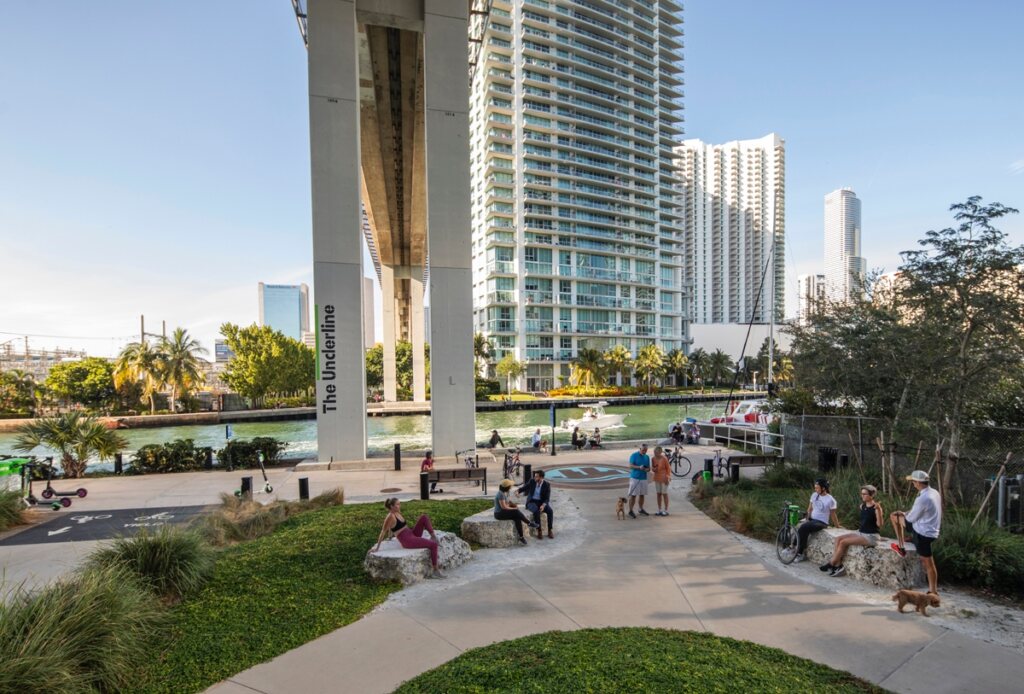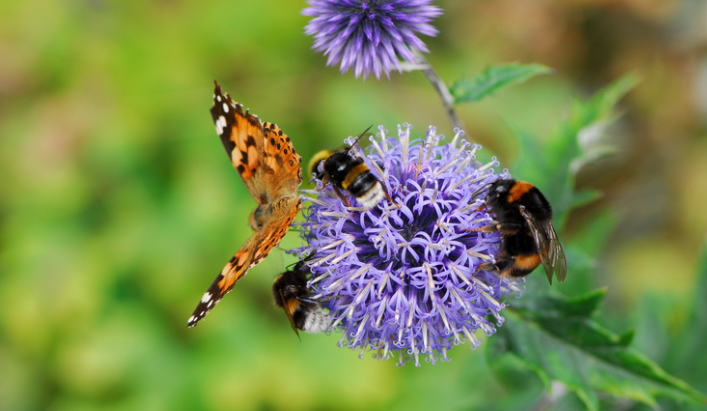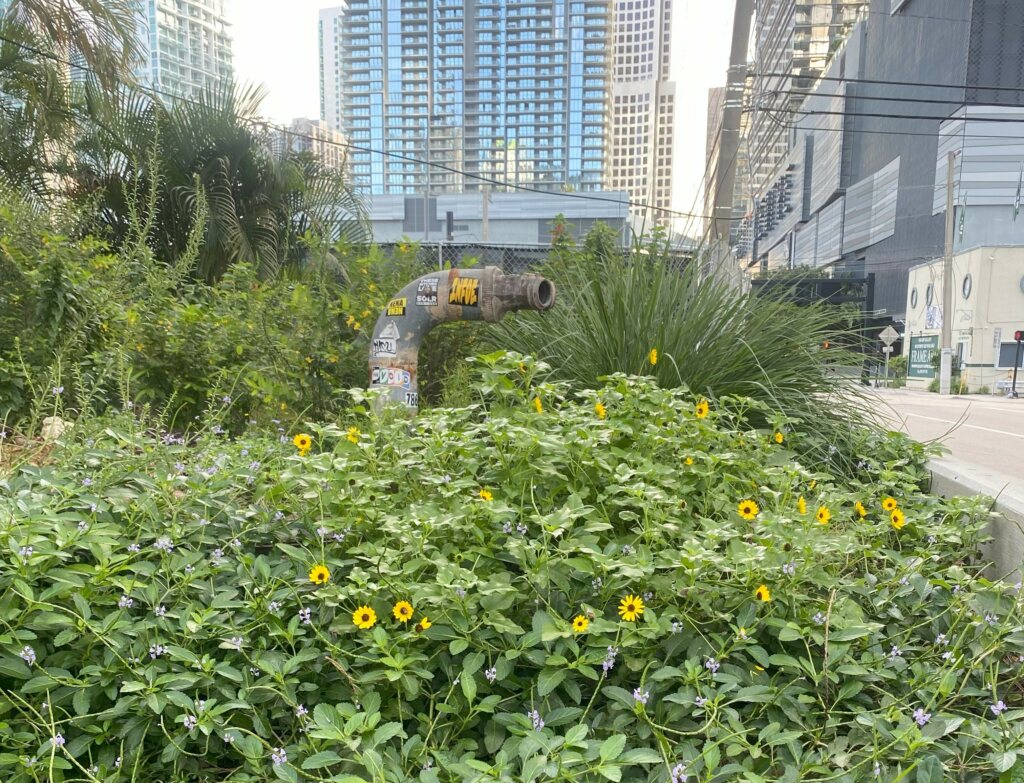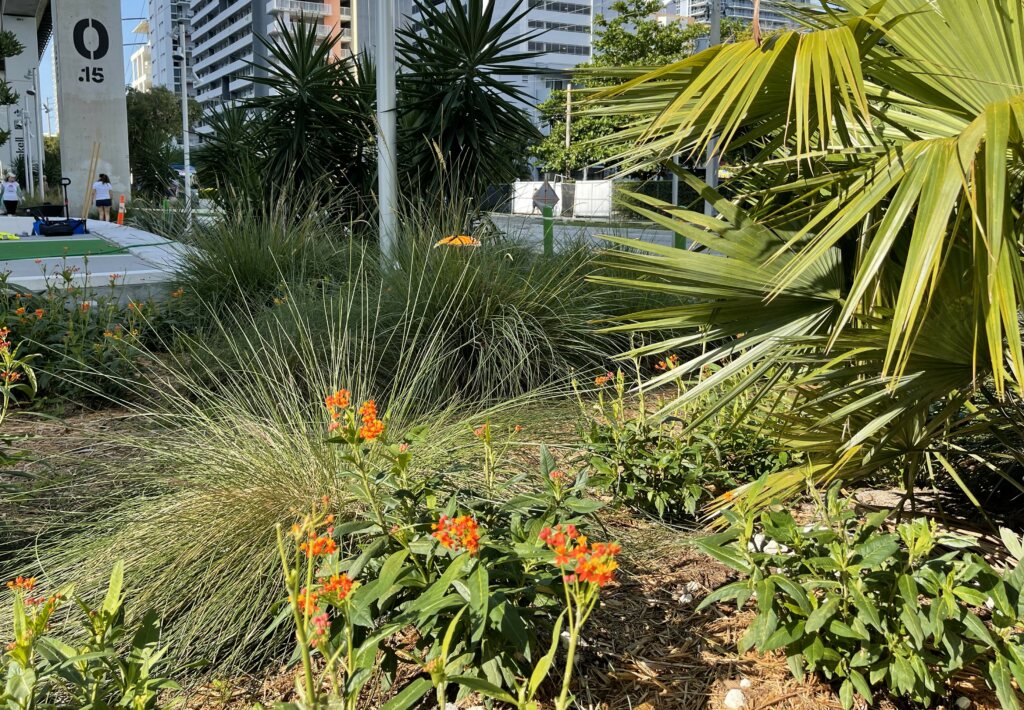River Room
between SW 7th St and Miami River

The River Room connects The Underline to the Miami River Greenway and the Miami River.
The Miami River is an important natural waterway in our city, originally flowing from the Florida Everglades and into Biscayne Bay. It provides a habitat for our manatees, dolphins, fish, and many wading birds which you can spot along this section of The Underline. It adds beauty, facilitates transportation and provides recreational opportunities in our city.
Pollinators on the Underline

Hello there! Did you see me fly by? I am one of your friendly native pollinators! Pollinators can be butterflies, bees, moths, beetles, flies, mosquitoes or even bats! You can meet different types of pollinators all along The Underline’s gardens. Butterflies are the easiest to spot, so keep your eyes peeled for our colorful wings!
Here in the River Room, you can spot Cassius blue butterflies, scientific name Leptotes cassius. We are light blue and at the bottom of our wings we have two small brown dots that look like eyes. We are some of South Florida’s smallest butterflies (only three quarters of an inch!) so look very closely if you want to find us. Can you see us?
What do pollinators do and why are we so important? Pollinators visit flowers to drink their sugary nectar (yum!). But flowers are also covered in a yellow powder, known as pollen. Pollen is dust like and will one day become the seeds of the new flowering plant.
When I land on a flower to get my sweet drink, that dusty pollen gets stuck on my legs. I visit many flowers in a day, picking up grains of pollen from new flowers and dropping off pollen from other flowers. This exchange of pollen is called “pollination” and is part of the process that creates the fruits and seeds that plants produce.
Pollinators are responsible for spreading the seeds of 75% of the world’s flowering plants. Many of those plants include the fruits and vegetables we eat, the plants we use to make our clothing (like cotton), the wood to build our homes (like oak and mahogany), and even many of our medicines (like aspirin!). Without pollinators, we would not have any of these important things!
The more pollinators you see, the healthier your environment is! Seeing less bees like me means that you may witness the effects of climate change. Why? Because butterflies, bees and other pollinators are very sensitive to the changes in our environment and important for more plants to grow.. Hotter temperatures and urban development change our native habitat. Sometimes the plants we use as food start to disappear and we must find new homes.
But good news, you can plant gardens around your city to help us find homes! Keep reading about urban gardening to learn how to help keep pollinators and our environment healthy!!
Do you see any other pollinators here in the River Room? Snap a pic! Post your pics and be sure to tag us! #climatechamps @theunderlinemia
Urban Gardens
Urban gardening is when plants are grown in an urban environment, like a city or town. Urban gardens make our cities look more beautiful while they help clean the air and the water. They give us shade and cooler temperatures. They provide homes for our birds, insects, lizards and squirrels. It is like creating a secret garden in downtown.
Native plants are a great option for urban gardens since they are well-adapted to their local environment and don’t need a lot of help to grow. For example, plants that are native to South Florida know how to survive our weather patterns. This means they are used to getting water in the rainy season and staying dry in the dry season, so we don’t need to use extra resources to water them.

Using native plants conserves other resources too! Native plants are adapted to our local soils so they don’t need extra fertilizers to help them grow, and most of them know how to fight off common diseases and attacks from pests, so we don’t have to use harmful chemical pesticides! That is a huge win for our planet!
Do you see that river over there? It is the Miami River. Everything we put into the ground eventually makes its way to the river and then out to the ocean. So, the fewer fertilizers and pesticides we use, the better for our oceans!
Not only do native plants help keep our planet clean, they also provide food and shelter for birds and insects, including pollinators. In fact, if you look closely, you will see pollinators like bees and butterflies such as Atala, Monarch, Cassius Blue and Sulphur all throughout The Underline.
Fun fact: When gardens are designed to require no water it is called “xeriscaping”. The term originates from the Greek word “xeros” that means “dry” or “arid”, it basically means dry landscaping. The Underline practices xeriscaping so we can conserve our precious water resource. Look around, all the plants you see are watered only by the rain!
Changing the Grade
Did you know this whole area used to flood? It’s true. When it rains heavily, the rainwater used to flood the streets and sidewalk where you are standing.
To solve this problem The Underline increased the elevation or “grading” from SW 7th Street to taper down to the Miami River. “Grading” is done by removing soil from some places and adding soil to others to create gentle hills and slopes. It helps direct water from a place of higher elevation to a place of lower elevation.
This grading creates a slope that allows water to slowly drain towards the river rather than the nearby streets or flooding The Underline’s gardens. As the water slowly flows towards the river it also gets absorbed into the soil around it and into the roots of the plants in the garden. This means water that used to create flooding problems for cars and pedestrians now creates benefits as it waters our plants and trees.
